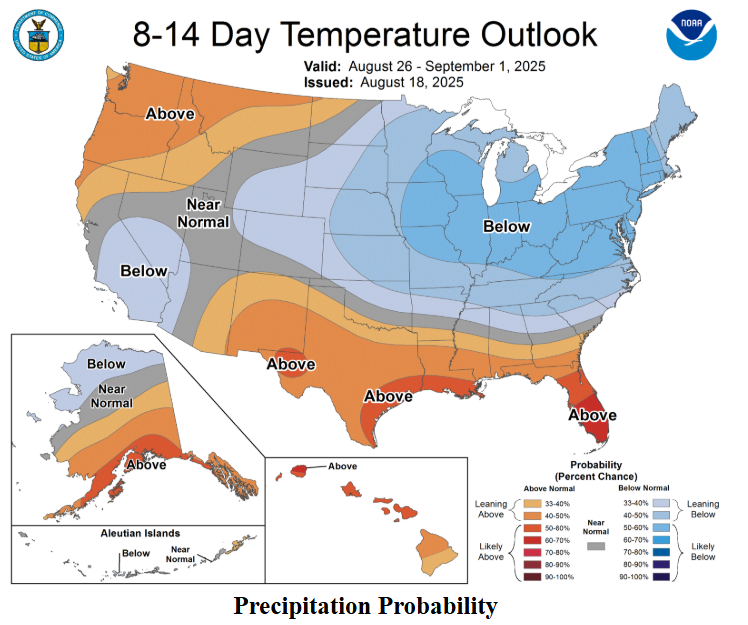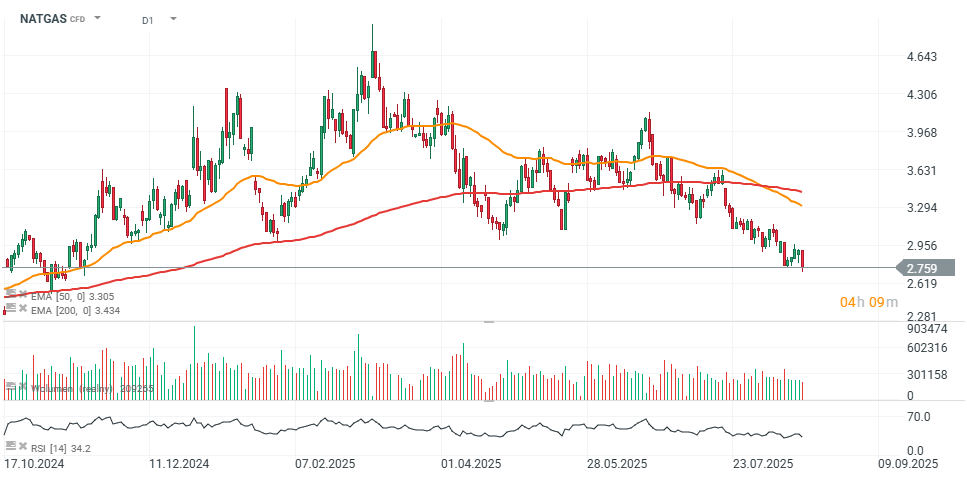U.S. Henry Hub natural gas futures (NATGAS) are down nearly 6% today, falling to almost nine-month lows. The decline is driven by high production levels, the absence of heatwave forecasts in the U.S., and expectations for weaker demand at the start of September. An additional factor weighing on prices is a drop in gas volumes flowing to LNG export facilities.
According to data from LSEG, average gas output in the 48 contiguous U.S. states rose to 108.5 billion cubic feet per day (bcfd) in August, up from 107.8 bcfd in July. Weather forecasts indicate conditions will remain mostly normal through early September, a cooler outlook than previously expected. The hot start to summer is giving way to milder conditions, while producers have ramped up output.

Source: NOAA
U.S. gas inventories are currently about 6% above the seasonal average, and analysts project storage levels will continue rising at a faster-than-usual pace in the coming weeks. Gas demand is forecast to ease from 110 bcfd this week to 105.7 bcfd next week, a downward revision compared with Monday’s outlook.
On a daily basis, LNG feedgas deliveries were expected to rise to 15.3 bcfd on Tuesday from a two-week low of 14.2 bcfd on Monday, following curtailments at several plants, including Cheniere Energy’s Sabine Pass facility.
The Erin Hurricane
Meanwhile, the U.S. National Hurricane Center (NHC) forecasts that Atlantic Hurricane Erin, currently near the Bahamas, will track north and then east along the U.S. East Coast this week without making landfall.
Erin could, however, bring tropical storm conditions on Thursday and is likely to cool temperatures along the East Coast.
- The NHC estimates that Erin has a 60% chance of strengthening into a cyclone within the week as it moves west. While hurricanes can at times support gas prices by disrupting production in the Gulf of Mexico, they more often reduce demand by shutting LNG export facilities and cutting power to millions of homes and businesses.
- This lowers gas consumption by power plants. Only about 2% of total U.S. gas production comes from the offshore Gulf of Mexico, while more than 40% of U.S. electricity is generated by gas-fired power plants. Hurricanes can also contribute to cooler weather patterns.

Source: xStation5
Daily summary: Wall Street tries to rebound 📈Amazon and Microsoft under pressure of Rotschild & Co Redburn
Cocoa tries to stabilize after autumn sell-off 📌
Fed's Barkin remarks on US economy 🗽EURUSD drops to 1.157
📌US500 loses 1%
This content has been created by XTB S.A. This service is provided by XTB S.A., with its registered office in Warsaw, at Prosta 67, 00-838 Warsaw, Poland, entered in the register of entrepreneurs of the National Court Register (Krajowy Rejestr Sądowy) conducted by District Court for the Capital City of Warsaw, XII Commercial Division of the National Court Register under KRS number 0000217580, REGON number 015803782 and Tax Identification Number (NIP) 527-24-43-955, with the fully paid up share capital in the amount of PLN 5.869.181,75. XTB S.A. conducts brokerage activities on the basis of the license granted by Polish Securities and Exchange Commission on 8th November 2005 No. DDM-M-4021-57-1/2005 and is supervised by Polish Supervision Authority.


